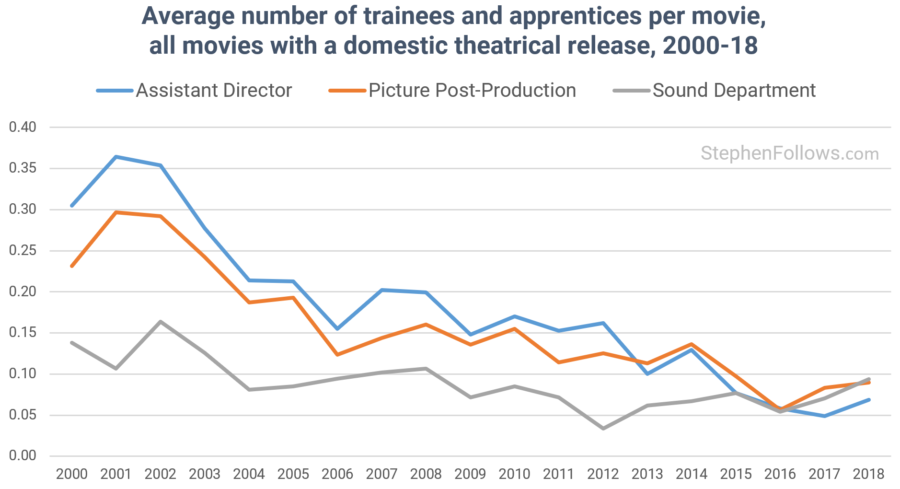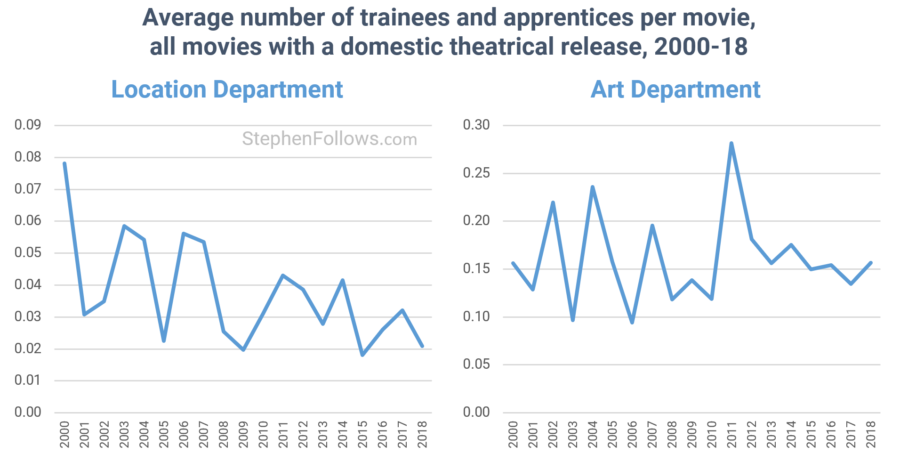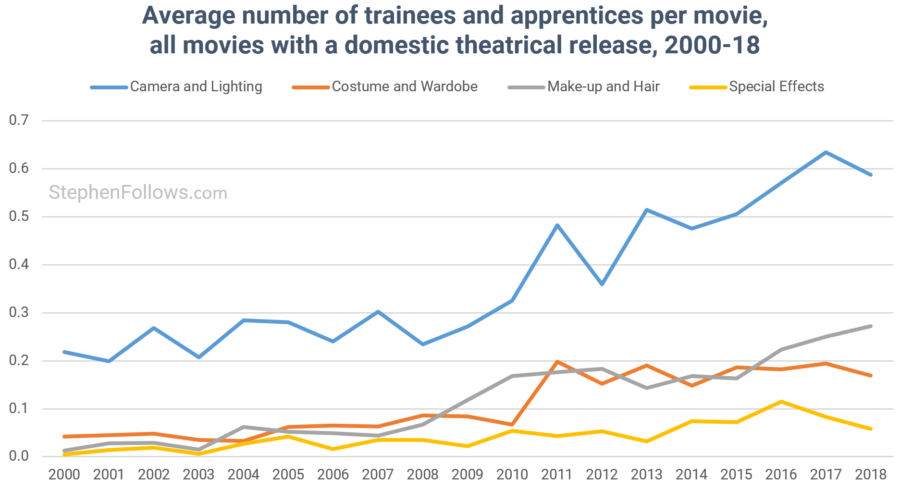
Last week, I looked at how jobs in the film industry have shifted over the past two decades.
Today, I am turning to a related topic, that of trainees and apprentices. These are programmes for new entrants to the industry in which they receive hands-on training and support while they learn the ropes. They are typically paid less than normal entry-level jobs, or their wages are subsidised by public or industry schemes.
In order to assess whether such roles are becoming more or less common, I studied the 7,905 feature films which were released in North American cinemas between 2000 and 2018, inclusive. Looking at the credits on each film, I zeroed in on trainees and apprentices within the nine departments which most frequently employ such new entrants, namely:
- Art Department
- Assistant Director
- Camera & Lighting
- Costume & Wardrobe
- Location
- Make-up & Hair
- Picture Post-Production
- Sound Department
- Special Effects
The list above is alphabetical but in this article we will be exploring them in order of how much their attitude to trainees has changed over the past two decades. First, we will look at the three departments which have shown the greatest decline in the hiring of trainees and apprentices, eventually moving to the departments which have shown the greatest increase.
So, before we move on to the data, take a moment to think about which departments you think have seen the largest fall in such roles over the past two decades.
….
…
..
.
The film departments with declining trainees
The departments with the greatest fall in trainee roles are Assistant Directors, Picture Post-Production and Sound.
In 2001, the average movie had 0.30 ADs on a trainee scheme whereas by 2018 that had fallen to 0.07. Over that same period, editorial trainees fell from 0.30 per movie to just 0.09 and sound trainees fell from 0.14 to 0.09 (with a low of 0.03 in 2012).

The middle two
Next we look at the Art and Location Departments. We saw last week how one of the fastest-growing roles in film is that of Location Co-ordinator, so it’s interesting to see a zigzagging decline in Location Trainees, perhaps suggesting that location departments are skipping formal training schemes in favour of teaching new entrants on the job.
Art departments have not shown any meaningful change in their use of trainees and apprenticeships over this period.

The film departments employing more trainees
We’re moving past the declining departments, onto those showing strong growth. The Camera department has traditionally always had a strong culture of apprenticeship, which makes their recent increase in trainees all the more impressive given that they were coming from a strong base. In 2001, the average film had 0.2 camera trainees whereas by 2017 that had more than tripled.
But the crown for the department showing the greatest proportional increase in trainees goes to the Special Effects department, with Hair and Make-up in second place.

Why this matters
Apprenticeships and trainee programs play a vital, symbiotic role in the industry. The trainees receive invaluable on-the-job training and support in highly specialised roles. In return, the industry gets keen workers at a low (or subsidised) rate, a diversity of experiences and the knowledge that they’re paying forward the help they received when starting out.
I wanted to give the final word to someone who can speak far more eloquently on the topic than I. Gareth Ellis-Unwin is both an Oscar-winning producer (The King’s Speech) and the Head of Film and Animation at ScreenSkills, which is the industry-led skills body for the UK’s screen industries. I asked him to add his thoughts to this piece and here’s what he had to say:
It is of course very worrying to see any downward trend in traineeships and apprenticeships being offered in the motion picture industry. Most of us in the industry started out as trainees, runners and PA’s, and had we not been given that opportunity would not now find ourselves in a career we love and cherish. Those starting out on their screen career are an essential part of the labour force, and sit at the very entry point of the talent delivery pipeline that is vital to the continuing world-beating performance of the Film and TV industries in the UK. Whilst we are currently facing challenges in the way we make our movies, it is extremely important that traineeship and apprenticeship opportunities don’t become a further victim to these tough times.
Notes
The raw data for today’s research came from IMDb and Wikipedia. I opted not to include data from 2019 as movie credits can sometimes take a while to be added to credit listing sites. The ranking is based on the change between the 2000-04 average and the 2015-18 average.
Our unit of measurements is ‘credits per movie’, which takes the total number of trainee credits in a year and divides it by the total number of movies released that year. I used this method as the number of movies released each year has been increasing, so the raw number of such credits is buoyed. As I am interested in the industry’s support of trainees, it’s not the raw number of trainees which matters but the scale of support across all movies. That said, for the departments with the greatest declines, the raw numbers of credited trainees also fell, not just the ‘credits per movie’.





Comments
Thanks for an enlightening read. I am interested in the costume department’s traineeship record as my daughter recently got to work on a feature film in the costume team for a few weeks before going to uni. The costume designer Said to her she felt the sector wasn’t doing enough to attract new talent but I don’t know of any apprenticeship schemes and wondered if you had come across any data on costume departments?
Creative areas are vital but so too are financial areas of expertise. Production Accountants are really hard to find right now, and there needs to be a serious uptick in training in this area.